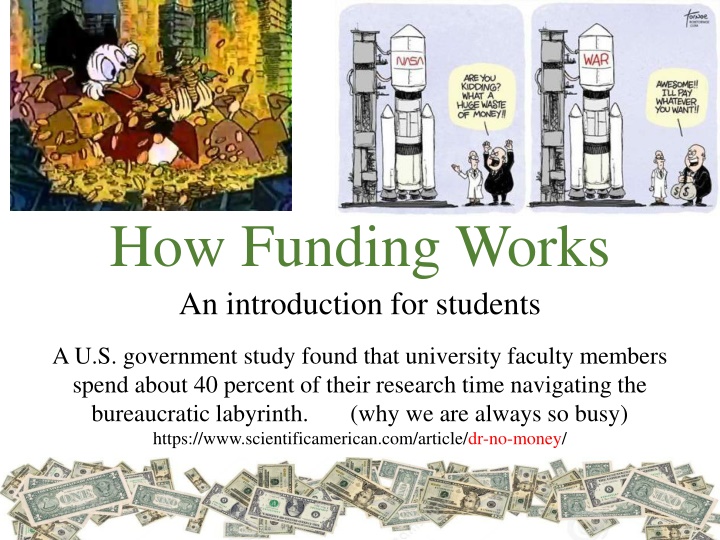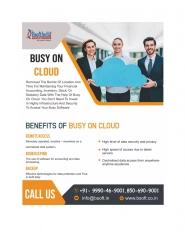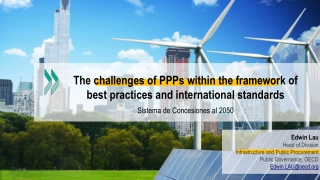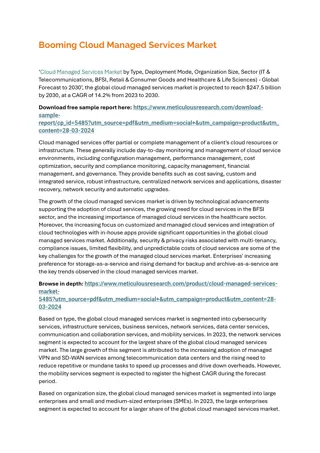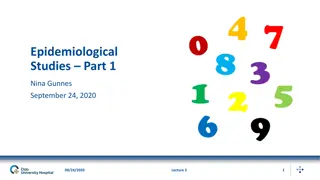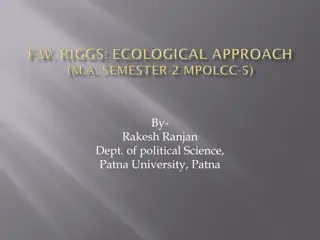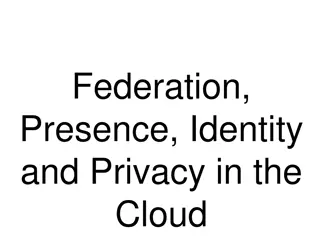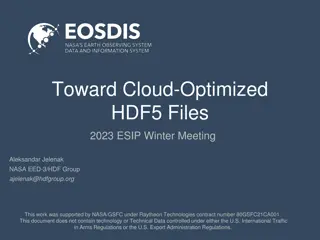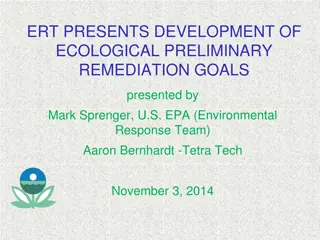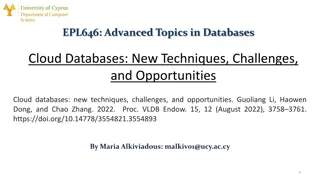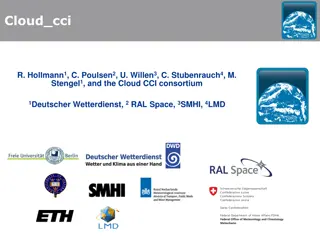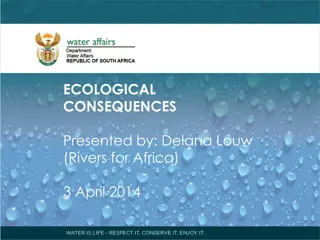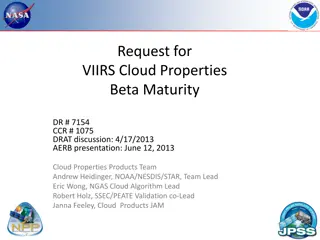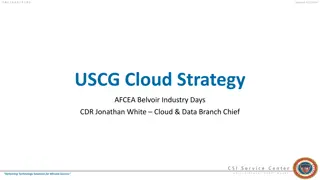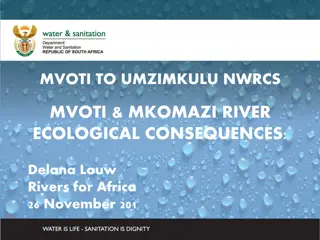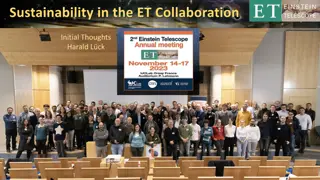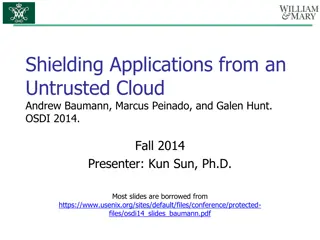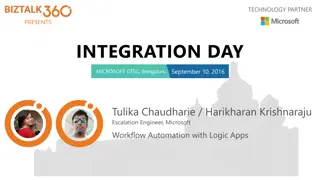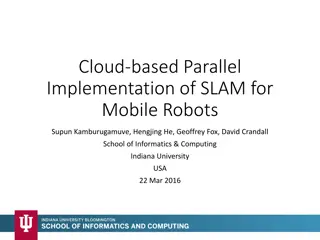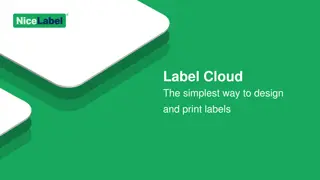Cloud-Based E-Infrastructure for Ecological Data Integration
"This project focuses on developing a cloud-based e-infrastructure for integrating data from various ecological sources, providing standard access to climate algorithms, and enabling parallel computation for data processing. The system aims to link data, facilitate data subscription and delivery, and ensure secure access and control. By deploying services on cloud platforms, the project aims to streamline data management, improve data visualization, and enhance data modeling activities. Sustainability and scalability are key considerations, with a vision to serve a growing community of researchers."
Download Presentation

Please find below an Image/Link to download the presentation.
The content on the website is provided AS IS for your information and personal use only. It may not be sold, licensed, or shared on other websites without obtaining consent from the author.If you encounter any issues during the download, it is possible that the publisher has removed the file from their server.
You are allowed to download the files provided on this website for personal or commercial use, subject to the condition that they are used lawfully. All files are the property of their respective owners.
The content on the website is provided AS IS for your information and personal use only. It may not be sold, licensed, or shared on other websites without obtaining consent from the author.
E N D
Presentation Transcript
Apology: I just wrote this talk, so haven t had too much time for finding amusing/illustrative figures. How Funding Works An introduction for students A U.S. government study found that university faculty members spend about 40 percent of their research time navigating the bureaucratic labyrinth. (why we are always so busy) https://www.scientificamerican.com/article/dr-no-money/
~ Half of these slides were adapted from Erica Whitney, Associate Director of UC Berkeley Research Office Outline My proposal experience (an example) An example budget How do you get a grant? Types of funding opportunities What goes into a proposal? Dealing with rejection and how to respond
You can request to help! Just keep in mind that if its close to a deadline some may prefer to do themself. My Proposal Experience (Note there are many experts here) Undergrad: helped typo check and manage the collection of documents for multi-investigator proposal Grad: assisted with scientific ideas (20 person group) Scholarships and fellowships (full tuition and 2 grad) Beamtime proposals (~2 per year then, now more) Major Research Instrumentation grant for PLD (Co-PI) Higher Education Policy Commission (Co-PI) Served on various types of review panels (helpful) Recently: NSF, DoE & American Chemical Society
You Fall Before You Learn to Walk My Rejections: (National acceptance rates 10-20%) Reducing Magnetic Dead Layers in Complex Oxides for Increased Interface Coupling, DOE Early Career, 2010 Controlling Interface Valency in Complex Oxides for Increased Magnetoelectric Coupling, DARPA Young Faculty Award, 2010 Optimizing Interface Physics to Magnetize Students and Materials (M. Holcomb, PI), NSF-Career Award, 2010 High-Resolution and Low-Temperature Magnetic/Ferroelectric Microscopy for Nonlinear Optical Imaging of Multifunctional Oxide Nanostrucutures (M. Holcomb, PI, David Lederman and Stuart Wolf), DOD DURIP, 2010 Interface Engineered Multilayer Thin Films for Room-Temperature Precision Magnetic Sensing, Air Force Young Investigator, 2010 Interface Engineered Complex Oxides for Room-Temperature Precision Magnetic Sensing, ONR Young Investigator Program, 2010 MRI-R2: High-resolution and Low-temperature Magnetic Microscopy for Nonlinear Optical Imaging of Complex Nanostructures (M. Holcomb, PI, A. Bristow, F. Ganikhanov, S. Wolf, N. Wu), NSF, 2011 MRI-R2: Acquisition of a Field Emission Scanning Transmission Electron Microscope for West Virginia University (X. Song, PI, D. Lederman, E. Sabosky, S. Urazdin, N. Wu), NSF, 2011 Rural Workforce Development in STEM Fields (E. Toth, PI, Z. Dinu, R. Hensel, M. Holcomb, and D. Simien, Co-PIs), NSF, 2011 Depth-Dependent Studies of Factors Influencing Magnetic Dead Layers (M. Holcomb, D. Lederman and N. Tolk), NSF, 2011 Reducing Magnetic Dead Layers in Complex Oxides for Increased Interface Coupling (M. Holcomb, PI), DOE Early Career, 2011 Material Interfaces for Efficient, Novel Generation and Conversion of Energy (M. Holcomb, PI), Petroleum Research Fund, 2011 Optimizing Interface Physics to Magnetize Students and Materials (M. Holcomb, PI), NSF Career Award, 2011 Improving Device Energy Efficiency and Speed by Optimizing Interfacial Coupling (M. Holcomb, PI), ARO, 2012 Rural Workforce Development in STEM Fields (E. Toth, PI, Co-PIs: C. Dinu, M. Holcomb, and D. Simien), NSF/ATE, 2012 Strategic Approach to Identifying Coupling Mechanisms at Heterostructure Interfaces (M. Holcomb, PI), NSF/CMP, 2012 Depth-Dependent Studies of Interfacial Mechanisms in Complex Oxides (Holcomb, Lederman, Stanescu, and Tolk), DOE, 2012 Improving Device Energy Efficiency and Speed by Optimizing Coupling (M. Holcomb, PI), NSF/EPMD, 2012 Center for Strongly Correlated Oxides for Revolutionary Electronics (SCORE) (S. Wolf, PI, R. Averitt, B. Butler, G. Dionne, J. Eckstein, J. Floro, A. Ghosh, L. Harriott, M. Holcomb, D. Lederman, S. Levitan, A. Lukaszew, J. Lu, C. Mewes, T. Mewes, J. Poon, C. Ross, K. Smith, M. Stan, B. Weikle, J-M Zuo, Co-PIs), SRC/DARPA,, 2012 3D Architecture from 2D Devices (A. Ramirez, PI, E. Andrei, A. Bristow, S.-W. Cheong, M. Chhowalla, L.C. Feldman, L. Fu, E.L. Garfunkel, G.-H.Gweon, D. Heiman, J. Heremans, M. Holcomb, S.M. Kang, N. Kobayashi, D.V. Lang, D. Lederman, J. Moodera, S. Oh, K. Pedrotti, W.E. Pickett, T. Siegrist, T. Stanescu, M.A. Subramanian, D. Vanderbilt, Co-PIs), SRC/DARPA, 2012 Critical Mechanisms Responsible for Magnetic Dead Layers in Complex Oxides (M. Holcomb, PI, Collaborator: S. Satpathy), NSF-CMP, 2013 Rural Workforce Development in STEM fields (Toth, PI, Holcomb Co-PI), NSF/ATE, 2013 Magnetizing Students and Materials by Investigating Science at Its Boundaries (Holcomb PI), Research Corporation, 2013 MRI: Acquisition of High Resolution and Low Temperature Magnetic Microscopy for Nonlinear Optical Imaging of Complex Nanostructures (M. Holcomb, PI; A. Bristow, C. Cen, P. Gannett and D. Lederman, Co-PIs), NSF/MRI, 2013 Project/Proposal Title: DMREF: Searching for Emergent Electronic Phenomena at Interfaces in Fluoride-Based Materials (A. Romero, PI; C. Cen, M. Holcomb, D. Lederman, and T. Stanescu, Co- PIs), NSF/DMREF, 2013 Electronic and Optical Properties of Stacked Two-Dimensional Materials (D. Lederman, PI; Y. Glinka J. Heremans, M. Holcomb, C. Tao, Co-PIs), ERFI 2-DARE, 2013 Chemistry at Low Symmetry Interfaces (M. Holcomb, PI), Chemical Society, 2014 Depth-Dependent Studies of Interfacial Mechanisms in Complex Oxides (M. Holcomb, PI; D. Lederman and T. Stanescu, Co-PIs), DOE, 2014 OP: Optical Measurements of Capping Layer Effects on Strongly Correlated Oxides (M. Holcomb, PI), NSF,, 2014 Reanimating Magnetic Dead Layers: Enhancing Magnetism in Strongly Correlated Oxides (M. Holcomb, PI), DOE Early Career, 2015 Interfacial Properties of Designed Peptides Coated onto Metal Nanostructures (PI: Lewis; Co-PIs: Holcomb and Guillion), NSF-CBET, 2015 Point: Lots of them
Why Do You Need a Grant? Need money to do your research: Personnel Equipment (not all grants) Supplies Travel Build a record of funding Employment, tenure/promotion Salary Prestige/Respect
An Example Budget (They Vary) Typical NSF grant for three years ~ 450K (~300K for single) University takes ~ 1/3 for overhead 300 K left, ~100 K per year Student salary ~ 24K Plus benefits makes it more like 26.5K Two students would be over half of remaining $ Typically 10-20K supplies or shared facilities (exp) Travel, varies, a few K if not doing field research Need any equipment? (Not room for anything expensive) 0.5-1 month of PI time. Are there collaborators? Example 36K subaward with NCSU
How Do I Get a Grant? (Details later) Define your research question. Define why anyone should care about this question. Match your research question to a granting agency that has awards that would meet your needs. Get feedback from at least one successful, trusted mentor. Write a grant proposal. Edit the grant proposal. Get feedback from more successful, trusted mentors. Edit the grant proposal again based on feedback. Have people (students?) check it for typos & other errors. Don t be ashamed to ask for help. There are resources.
Define Your Research Question Identify a gap in knowledge in your field. Identify a problem whose solution will be a big step forward for the field, rather than an incremental step. Choose a problem that is going to matter to more people than just you. Discern whether or not someone else has already asked your question. Often someone has, but have they done it well enough? Remember that you don t want incremental.
What do you need to do work? What do I need in order to do my research that I don t already have? How much do I need? Your budget limits how much you can accomplish and how quickly. Who do I need to help me? Collaborators, students, technicians, staff
Sources of Funding Federal Government: National Science Foundation Department of Energy Department of Defense NIH, etc. State/Local Government Corporations (Warning: often don t like to publish) Foundations (Mission driven) Your university (internal funds)
Match Your Research Question to an Agency Identify the right type of grant for your research question. E.g., an equipment grant, career development grant, etc. Every funding agency has a mission. Your research MUST address their mission to be funded. Talk to a mentor you trust (ideally one with funding from selected agency). Share your ideas and listen! You should then talk with an agency program officer before writing the rest of the proposal to seek their advice on whether your topic is a good fit.
If the program officer likes it (congrats) First step: Read the D*?! Directions Follow proposal instructions exactly. Format varies with sponsor. Don t try to get around length limits by using tiny fonts, small margins, or appendices. (Some reviewers have old eyes and impressions matter!) Many agencies reject such grants without review! (After you ve spent months, this is no fun.)
Give Yourself Plenty of Time! (helpful) an expert (if needed) Many people try to squeeze this into a month and there is just not time to do everything well!
Tips when writing the proposal Use the active voice where possible. Write to your audience. Donut rely on spell-check. Have others read and critique your proposal! Particularly if English is not your first language, but we all make mistakes. (particularly when rushed) At least one of your readers should be an expert in the field (they catch problems with the science), but will typically not be bothered with typos Your grad students are great medium level readers and may also bring up good scientific points. Also get someone who is a perfectionist. They do not have to be a scientist, but that can help. (Grammar/format help)
What goes into a proposal? Most include: - Abstract/Summary (up to 1 page) - Problem statement: What is the problem you will address - Specific aims/goals - Significance and Background (why the taxpayer should care and what s already been done) - Research Plan (the experiments you plan to do, what they will tell you and what you will do if they don t give you the results you expect) - Preliminary data/feasibility (proof you can do it!) - Timeline - Resources and facilities - Personnel list and biosketches/CVs - Budget All of these take time!
Not everyone believes its this bad, but there is some truth to it.
How are proposals reviewed? Important to keep your audience in mind Most: Peer review 3-5 scientists in condensed matter will review it Agency has set review criteria. Provide written critiques and a numerical score. Some peer review plus stakeholders. For some foundations and agencies (In-house review)
How are proposals reviewed? In a panel, each person reads and reviews 6++ proposals and the panel discusses. (My largest panel 34) In-person meetings. Internet meetings. Written comments sent (may be combined with panel) Reviewers are busy scientists. Impressions matter.
Dealing with Rejection: Shit Happens Nearly every professor has faced multiple funding rejections! Take some time to allow the sting to lessen. (relax your way) Do not call the program officer to complain! Analyze every single rejection you receive If you want to be approved for funding in the future you absolutely must understand why your idea was rejected in the past. View rejection as a challenge (easier said than done) Rejection is going to happen, but how you use that rejection can completely transform how much you re able to accomplish. Explore other sources of funding
A Few Common Reviewer Comments One reviewer expressed uncertainty in how the optical measurements lead to a better understanding of the cause of magnetic dead layers. Had to show preliminary work showing differences between related samples and argue why this information was important to proposal goal. Also discussed alternative experiments. Some concern among reviewers that a closer collaboration between growth and characterization should exist. (Despite letters of support) Largely why we grow our own films now. Alternative approach: put in some funding for the grower common for theory too
Ways You Might Get Experience Discuss with your prof ways they might appreciate help Identifying unusual funding opportunities Come up with big ideas (ideally related to current work) Not only have a good idea but demonstrate you can do it Otherwise, consider keeping your idea for your future work Literature search, background research (use for thesis?) Planning the necessary experiments and back-ups Additional Materials (data management, CPs, etc.) Bugging Encouraging Co-PIs to submit their materials
Finding Funding Opportunities Lots of ways Use a database. pivot.cos.com grants.gov Go directly to the sponsor s website. http://grants.nih.gov/funding/index.htm http://www.cancer.gov/grants-training Sign up for email alerts.
Some Take Away Messages Don t expect to get a grant the first time you write about a new topic .or maybe even the 2nd or 3rd Give yourself plenty of time to work on proposals, partly because errors are easy to miss if you rush Get advice from MANY people at different stages, some very early (the idea stage) - also takes time Evaluate feedback and consider what you can do to alleviate concerns. What you should do may not be exactly what was suggested.
